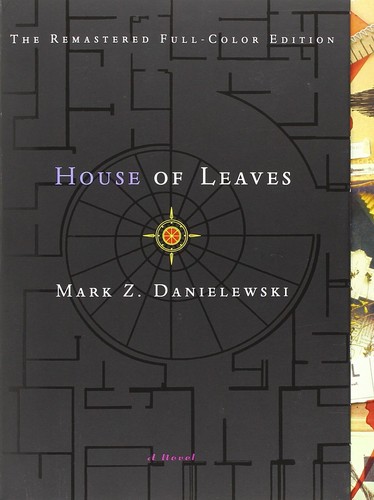Steve reviewed House of Leaves by Mark Z. Danielewski
House of Leaves
Great book with great twists and turns.
Had me measuring the inside of my house and comparing it with the outside.

Hardcover, 376 pages
English language
Published 2006 by Pantheon.
Great book with great twists and turns.
Had me measuring the inside of my house and comparing it with the outside.
So here’s the story: Will Navidson and his family move into a house. Previously unseen doors mysteriously appear. Will and friends explore the labyrinthine rooms leading from these doors, and film their experiences. Mayhem and death ensue.
Navidson’s film generates much examination (cinematic critiques of the film itself, theories as to the physics of doors and rooms suddenly appearing, psychological studies of the characters, etc.). A character named Zampano (seemingly unknown to Navidson) prepares his own notes on the film and its subsequent analyses but dies before he is unable to complete the project. Johnny Truant takes Zampano’s notes and compiles them into a manuscript. The manuscript is then edited (we know this because of recurring “editor’s notes”). The result is layers upon layers of stories and by the end we are not sure any of it is real. Fairly early on, and again near the end of the book, …
So here’s the story: Will Navidson and his family move into a house. Previously unseen doors mysteriously appear. Will and friends explore the labyrinthine rooms leading from these doors, and film their experiences. Mayhem and death ensue.
Navidson’s film generates much examination (cinematic critiques of the film itself, theories as to the physics of doors and rooms suddenly appearing, psychological studies of the characters, etc.). A character named Zampano (seemingly unknown to Navidson) prepares his own notes on the film and its subsequent analyses but dies before he is unable to complete the project. Johnny Truant takes Zampano’s notes and compiles them into a manuscript. The manuscript is then edited (we know this because of recurring “editor’s notes”). The result is layers upon layers of stories and by the end we are not sure any of it is real. Fairly early on, and again near the end of the book, Truant admits to making things up. Metafiction, anyone?
I hope Mark Danielewski had fun with some of his smug construction techniques: certain words and passages printed in color, footnoted footnotes (where have I seen that before?), occasional footnotes that use odd characters rather than Arabic numerals (evidently we are supposed to use photographs in the book to decode these footnotes but I didn’t want to bother); an index that includes meaningless words (like “something” and “back”); initial letters of lists that spell out things including the author’s name.
Truant frequently interjects his own story via footnotes. He’s a mess. His life centers around drugs, sex, and the repercussions of abandonment and early childhood abuse—or not? Remember, he’s told us he lies.
There are no dimensional female characters. Navidson’s partner, Karen, gives us capital-D-Denial. Truant interacts with hookers and one night stands. Truant’s also got mother issues. Through a series of letters, we learn that Truant’s mother spent years in a mental health facility. (In another trick of construction, we get to decode one of her letters.)
The book’s weaknesses are redeemed by chapters 9 and 20. Here Danielewski has constructed the verbal equivalent of the labyrinth that Navidson is exploring. The book uses footnotes, page layout, color, and typography to evoke dead ends, backtracking, and a feeling of disorientation. Great fun to read the book while turning it sideways, flipping pages backwards, jumping forward or backward to find the referenced footnote—a truly disorienting, unique reading experience.